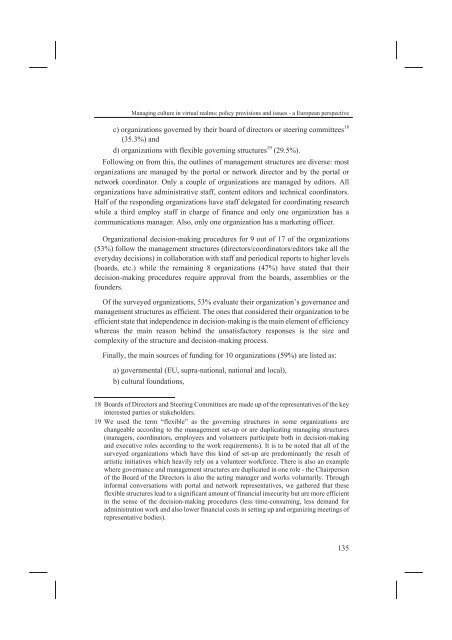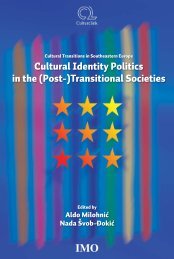D:\Documents and Settings\Ana\My Documents\Biserka-knjiga ...
D:\Documents and Settings\Ana\My Documents\Biserka-knjiga ...
D:\Documents and Settings\Ana\My Documents\Biserka-knjiga ...
Create successful ePaper yourself
Turn your PDF publications into a flip-book with our unique Google optimized e-Paper software.
Managing culture in virtual realms: policy provisions <strong>and</strong> issues - a European perspective<br />
c) organizations governed by their board of directors or steering committees 18<br />
(35.3%) <strong>and</strong><br />
d) organizations with flexible governing structures 19 (29.5%).<br />
Following on from this, the outlines of management structures are diverse: most<br />
organizations are managed by the portal or network director <strong>and</strong> by the portal or<br />
network coordinator. Only a couple of organizations are managed by editors. All<br />
organizations have administrative staff, content editors <strong>and</strong> technical coordinators.<br />
Half of the responding organizations have staff delegated for coordinating research<br />
while a third employ staff in charge of finance <strong>and</strong> only one organization has a<br />
communications manager. Also, only one organization has a marketing officer.<br />
Organizational decision-making procedures for 9 out of 17 of the organizations<br />
(53%) follow the management structures (directors/coordinators/editors take all the<br />
everyday decisions) in collaboration with staff <strong>and</strong> periodical reports to higher levels<br />
(boards, etc.) while the remaining 8 organizations (47%) have stated that their<br />
decision-making procedures require approval from the boards, assemblies or the<br />
founders.<br />
Of the surveyed organizations, 53% evaluate their organization’s governance <strong>and</strong><br />
management structures as efficient. The ones that considered their organization to be<br />
efficient state that independence in decision-making is the main element of efficiency<br />
whereas the main reason behind the unsatisfactory responses is the size <strong>and</strong><br />
complexity of the structure <strong>and</strong> decision-making process.<br />
Finally, the main sources of funding for 10 organizations (59%) are listed as:<br />
a) governmental (EU, supra-national, national <strong>and</strong> local),<br />
b) cultural foundations,<br />
18 Boards of Directors <strong>and</strong> Steering Committees are made up of the representatives of the key<br />
interested parties or stakeholders.<br />
19 We used the term “flexible” as the governing structures in some organizations are<br />
changeable according to the management set-up or are duplicating managing structures<br />
(managers, coordinators, employees <strong>and</strong> volunteers participate both in decision-making<br />
<strong>and</strong> executive roles according to the work requirements). It is to be noted that all of the<br />
surveyed organizations which have this kind of set-up are predominantly the result of<br />
artistic initiatives which heavily rely on a volunteer workforce. There is also an example<br />
where governance <strong>and</strong> management structures are duplicated in one role - the Chairperson<br />
of the Board of the Directors is also the acting manager <strong>and</strong> works voluntarily. Through<br />
informal conversations with portal <strong>and</strong> network representatives, we gathered that these<br />
flexible structures lead to a significant amount of financial insecurity but are more efficient<br />
in the sense of the decision-making procedures (less time-consuming, less dem<strong>and</strong> for<br />
administration work <strong>and</strong> also lower financial costs in setting up <strong>and</strong> organizing meetings of<br />
representative bodies).<br />
135



